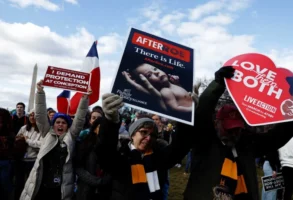
Published May 18, 2018
The Trump administration’s newly proposed rule, announced today, to make it harder to use federal Title X dollars to promote and provide abortion is a modest but significant and important step. The administration should be commended for advancing this important pro-life measure, and also for doing it in a way designed to maximize its actual effects while reducing (a little) the potential for political blowback and legal vulnerability around the move.
The rule is being met with much predictable gnashing of teeth on the left, at least some of it rooted in inaccurate descriptions of the reach of the rule. But the story of this particular regulatory maneuver reaches back three decades, and connects to a set of controversial disputes that reach back nearly half a century, to the origins of the Title X program itself.
Title X of the Public Health Service Act was enacted in 1970, and establishes a federal program to support family planning and reproductive health services for lower-income Americans—mostly by funding grants for community clinics that provide contraception, counseling, and related services. The program now disburses about $285 million a year in grants that are awarded regionally through a competitive process.
The statute, in section 1008, was written to specifically prohibit taxpayer support for abortion as a method of family planning, but it has been clear for decades that the boundary between Title X clinics and abortion clinics is often very porous. Planned Parenthood—which is the nation’s largest abortion provider by far—receives about a fifth of all Title X funds each year. This supports abortion not only because money is fungible within an organization but also because abortion clinics and Title X clinics (especially within Planned Parenthood’s network) are often located in the same facility, and the latter appear routinely to just provide referrals to the former.
Back in the late 1980s, the GAO (Congress’s watchdog agency) issued a report about the Title X program that noted that clinics seemed routinely to blur the lines between Title X services and the practice of abortion—often essentially referring patients to on-site abortions. The report recommended that HHS establish clearer regulatory barriers that set out the practical meaning of section 1008 of the statute.
The Reagan Administration responded to the report in 1988 with a set of regulations that prohibited Title X clinics from “co-locating” with abortion clinics in a single facility (saying they had to be “physically and financially separate”) and prohibited “counseling concerning the use of abortion as a method of family planning or to provide referral for abortion.” The regulation was instantly controversial, of course, but the political firestorm ended up focusing on the prohibition on counseling in particular, which quickly came to be dubbed a “gag rule” by opponents.
The Reagan rule was delayed while it was challenged in the courts, which took most of the first Bush administration. The challenge got all the way to the Supreme Court, where the Reagan rule was sustained in a 5-4 decision (in a 1991 case known as Rust v. Sullivan). There followed an intense political fight about the rule between Bush and the Democratically controlled Congress. That fight included passage of legislation to overturn the Reagan rule, a veto of that bill by President Bush, and an attempt to override the veto that succeeded in the Senate but came 10 votes shy of success in the House. By the time this all ended, Bill Clinton had gotten elected, and he threw out the Reagan rule in his first week in office.
The George W. Bush administration began the process of reinstating the rule at least twice, but declined to pull the trigger—largely because of concerns among congressional Republicans (and some administration officials who found it convenient to assign their own concerns to unnamed congressional Republicans) about a contentious fight over the “gag rule” that they didn’t want to have.
These efforts came closest to real action in Bush’s second term, when a regulation was fully drafted at HHS (it was very similar to Reagan’s 1988 rule, just updated to include new modes of disseminating information like email and the web and tightened in a few respects in light of the legal battles of the 1990s) and nearly adopted. (Full disclosure: These issues were in my portfolio as a White House staffer at the time, and I was one of the advocates of the idea and a coordinator of the process.)
That attempt was abandoned in the spring of 2006, in a deputies-level policy gathering that was one of the most contentious meetings I ever witnessed in government. It came as an intra-Republican battle over stem-cell-research funding was heating up on Capitol Hill (which would later conclude in a Bush veto of a funding bill) and as the administration also wanted to avoid alienating potential congressional allies from both parties at a particularly sensitive moment for its Iraq-war strategy. The combination of all these controversies at one time struck some in the administration and in Congress as untenable, and ultimately the decision was made to avoid another “gag rule” fight.
A proposal to reinstate the bulk of the Reagan rule but leave out the specific “gag rule” component—that is, the prohibition on counseling for abortion in Title X clinics—was considered near the end of that process. But by that time positions had pretty well hardened and its appeal didn’t win converts internally.
It is that trimmed and altered form of the rule that the Trump Administration has now put forward. Their rule is only being submitted for its first OMB review today—it will need to go through an inter-agency process and then a full public-comment rulemaking process, so it will take a little while. But as it now stands, it would reinstate the Reagan Administration language prohibiting co-location and instituting similar “program integrity” protections, as well as the restriction on direct referrals for abortion from Title X clinics. But it does not include a prohibition on counseling for abortion. This means it can’t really be described as a “gag rule” and that opponents will need instead to make the case that taxpayers should in fact be supporting clinics that share space and resources with or provide direct referrals to abortion clinics and yet that somehow this doesn’t violate the legal prohibition on Title X dollars supporting the practice of abortion.
As a practical matter, this form of the rule is likely to have nearly the same effect as one that includes the counseling language. The effect would be, most significantly, to make it much harder for Planned Parenthood clinics to receive Title X funding (since they couldn’t get funded without untangling their abortion services from Title X clinics, which they will find very hard to do), and so to meaningfully curb taxpayer support for the nation’s largest abortion provider.
It would only curb, rather than eliminate, that support because only about 13 percent of the roughly $450 million in annual federal funding for Planned Parenthood flows through Title X; the rest is spent through Medicaid, according to a 2015 estimate by the Congressional Budget Office.
The rule announced today is legally appropriate, because it acts on the statutory language that prohibits Title X funds from supporting abortion. It is constitutionally sound, as the Supreme Court ruled in Rust v. Sullivan. And it is morally right, because it curtails the use of taxpayer dollars to support a practice that many millions of taxpayers rightly regard as brutal and unconscionable—a taking of innocent human life, and so a grave, avoidable injustice and a stain upon the nation’s moral character.
This is just a modest step in the right direction on federal abortion policy, but every step counts.
— Yuval Levin is the editor of National Affairs and a fellow at the Ethics and Public Policy Center.








